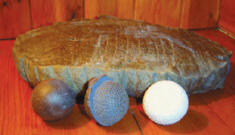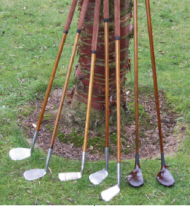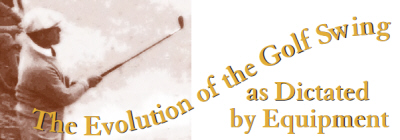The Evolution of the Golf Swing as Dictated by Equipment
From wooden golf balls to modern urethanecovered rockets, from tree branches to graphite- shafted aerodynamic titanium clubheads, the golf swing has evolved along with changes in the equipment used throughout the years. Here is a primer of how the golf swing has changed in response to the equipment being used at the time.
Feathery golf balls
The feathery was made by stuffing wet goose feathers into a leather pouch, sewing the pouch up, and the drying feathers expanded to make a

fairly hard, useable golf ball. Since the feathery didn’t have the aerodynamics we are familiar with today, it was best to keep the ball low to the ground. To achieve this, the top players would swing in a relatively flat, roundhouse manner known as the “St. Andrews swing.” This swing produced a draw.
Hickory-shafted golf clubs
For centuries, golf clubs were made with wooden shafts, often hickory. The shafts had a lot of torque, or twist, in them. This necessitated strong hand action and rotation in order to square the clubface at impact. To achieve this strong rotation, players would rotate through the ball with minimal lateral action, hitting against a firm left side.
Gutta-percha balls
The gutta-percha ball replaced the feathery in 1848. Dr. Robert Adams Paterson invented it at the time, being too poor to afford featheries (according to his New York Times obituary in 1904). Being far superior to the feathery, it soon became the ball of choice. Golfers then noticed that the ‘gutty’ flew farther when it got nicked up, and soon golfers began to put their own carvings into their new golf balls. Manufacturers then started

making their molds, first with outward-facing pips, and then with lines and the dimples we have come to know today.
In Jersey, England, the players found that if they swung more upright, they could get the gutty up in the air, which worked because of the aerodynamic properties of the gutty. Harry Vardon became the first notable golfer to swing in this manner.
Steel-shafted clubs
With the coming of steel shafts in the 1920s, the game was about to undergo a major change in swing motion. Since steel shafts had far less torque than hickory shafts, the old swing of aggressive rotation with the hands produced a hook with the steel shafts. To offset this, players soon found that they had to use their lower bodies much more actively than with hickory shafts, in order to prevent the clubface from being shut at impact. Byron Nelson is known as the father of the modern golf swing for being the first prominent golfer to use this new action.
Titanium drivers and solid-core balls
Not much changed for decades when it came to the swing since Nelson’s day, because the equipment remained virtually the same from the 1930s to the late 1980s – wound balls and persimmon drivers. There were differences in swing
styles which were player-influenced, but equipment per se did not influence the differences.
But, with the advent of metal drivers and solid-core balls, the swing changed again, although in more subtle ways. While some golfers, such as Arnold Palmer and Jack Nicklaus, were always encouraged to hit the ball as far as they could and worry about accuracy later, most were taught to have a controlled swing. Since the metal drivers offered more forgiveness than persimmon drivers, young golfers were encouraged to seek distance first, accuracy second. Solid-core premium balls, which became popular around 2000, spun less than the old wound balls, which meant that sidespin was also decreased, further limiting crooked tee shots. The result is a generation of free-swingers never before seen, perhaps most notably Bubba Watson.
The future
With so many recent constraints put on the driver from the R&A and the USGA, along with the premium golf ball nearing the maximum distance standard, it seems difficult to believe that swing changes in response to equipment changes will be forthcoming. However, the game has always evolved to some degree. So perhaps anything’s possible.





